SWEDISH SOUTH ASIAN STUDIES NETWORK
Visit to Indian Institute of Technology – Guwahati,
Web page: http://www.iitg.ernet.in/
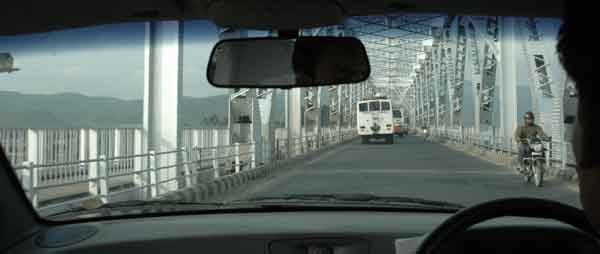 From
Gauhati University we proceeded 10 km outside the city, passing the imposing
bridge over the river Brahmaputra. In a hilly area covered with bushes,
the Indian Institute of Technology (IIT) Guwahati, is located. IIT Guwahati
was established already in 1995 in hired premises in Guwahati proper,
but new buildings are now constructed in what used to be wasteland on
the northern shore of Brahmaputra. It currently has a faculty of 200,
and around 1.800 students, but the number will increase when all the buildings
are completed in 2006.
From
Gauhati University we proceeded 10 km outside the city, passing the imposing
bridge over the river Brahmaputra. In a hilly area covered with bushes,
the Indian Institute of Technology (IIT) Guwahati, is located. IIT Guwahati
was established already in 1995 in hired premises in Guwahati proper,
but new buildings are now constructed in what used to be wasteland on
the northern shore of Brahmaputra. It currently has a faculty of 200,
and around 1.800 students, but the number will increase when all the buildings
are completed in 2006.
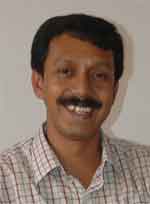 Our
contact person was Dr Chandan Mohanta
(photo to the left)at the Department
of Civil Engineering, and he received us in his office. Dr Mohanta
is involved in two collaborative projects with Swedish researchers. One
is a project on arseniferous groundwater, with Associate Professor Prosun
Bhattacharya, Department of Land and Water
Resources Engineering, Royal Institute of Technology, KTH, Stockholm.
Arsenic in groundwater is a very serious problem to inhabitants of the
region, mainly in Bangladesh and the Indian state of West Bengal. The
main research task is to find out how the arsenic in the sediments is
dissolved and gets into the groundwater, and the methods for the removal
of arsenic.
Our
contact person was Dr Chandan Mohanta
(photo to the left)at the Department
of Civil Engineering, and he received us in his office. Dr Mohanta
is involved in two collaborative projects with Swedish researchers. One
is a project on arseniferous groundwater, with Associate Professor Prosun
Bhattacharya, Department of Land and Water
Resources Engineering, Royal Institute of Technology, KTH, Stockholm.
Arsenic in groundwater is a very serious problem to inhabitants of the
region, mainly in Bangladesh and the Indian state of West Bengal. The
main research task is to find out how the arsenic in the sediments is
dissolved and gets into the groundwater, and the methods for the removal
of arsenic.
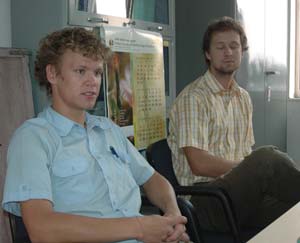 Two
Swedish students, Daniel Nordborg
and Gustav Enmark (photo
to the right), from Air & Water Science/Hydrology;
Department of Earth Sciences, Uppsala University (but supervised by Prosun
Bhattacharya and Chandan Mohanta), happened to stay at IIT Guwahati during
our visit, carrying out Minor Field Studies measuring the groundwater
arsenic contamination in wells in the Brahmaputra basin near Guwahati.
This will result in two 15 credits papers when they return back home.
They had been at the campus since the beginning of October and would stay
another few weeks. They told us about their experiences of hostel life
and their interaction with Indian students.
Two
Swedish students, Daniel Nordborg
and Gustav Enmark (photo
to the right), from Air & Water Science/Hydrology;
Department of Earth Sciences, Uppsala University (but supervised by Prosun
Bhattacharya and Chandan Mohanta), happened to stay at IIT Guwahati during
our visit, carrying out Minor Field Studies measuring the groundwater
arsenic contamination in wells in the Brahmaputra basin near Guwahati.
This will result in two 15 credits papers when they return back home.
They had been at the campus since the beginning of October and would stay
another few weeks. They told us about their experiences of hostel life
and their interaction with Indian students.
The other Swedish connection is a new collaborative project on prediction of earthquakes, that Chandan Mohanta is involved in together with Professor Alasdair Skelton from the Dept. of Geology and Geochemistry, Stockholm University. The project, called ”Monitoring the effect of seismic activity on groundwater chemistry in NE India” has recently got a Swedish Research Links funding from Sida and the Swedish Research Council, and it aims at finding means of accurately predicting earthquakes by studying the seismic activities in North East India, an extremely vulnerable area where a major earthquake is expected to hit the region in the near future.
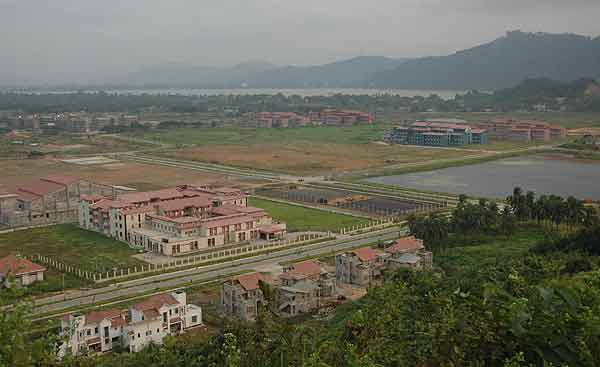 Dr
Chandan informed us about the specific facts that make IIT Guwahati a
bit different from the other, older Indian Institutes of Technology, for
example those in Kanpur, Chennai and Kharagpur. Due to the geographical
isolation of the North East from the rest of India there are less foreign
collaboration in Guwahati (the German Exchange
Academy, DAAD, being an exception). There are also few Internationally
funded research projects and not many senior researchers among the faculty.
Dr
Chandan informed us about the specific facts that make IIT Guwahati a
bit different from the other, older Indian Institutes of Technology, for
example those in Kanpur, Chennai and Kharagpur. Due to the geographical
isolation of the North East from the rest of India there are less foreign
collaboration in Guwahati (the German Exchange
Academy, DAAD, being an exception). There are also few Internationally
funded research projects and not many senior researchers among the faculty.
Less students make IIT Guwahati their primary choice. On the other hand
Guwahati has an edge over other IITs in that the institute is brand new,
so that laboratories can be better planned already before the buildings
have been completed.
IIT Guwahati is also different in that it clearly puts a focus on local/regional issues of importance. The motto for IIT Guwahati is”what can we do for this region”, and therefore give priority to research that provides support to the civil society, by offering small, meaningful and relevant technological interventions. Besides the subjects previously mentioned, Dr Mahanta added GIS mapping of the region, groundwater management, and specifically for the chemical engineers, the problem of pollution.
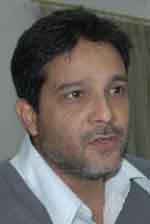 Just like
other people we met in the academia of the North East Dr Chandan was optimistic
about the future. If the borders can be opened up and India’s dream
of going east, that is expanding trade and other ties to South East Asia
and China through Burma, it means big possibilities for IIT Guwahati.
Just like
other people we met in the academia of the North East Dr Chandan was optimistic
about the future. If the borders can be opened up and India’s dream
of going east, that is expanding trade and other ties to South East Asia
and China through Burma, it means big possibilities for IIT Guwahati.
We also met the Head of the civil engineering department, Dr Sudip Talukdar, who was trained at IIT Kanpur; and Dr Gautam Barua (photo to the left), doing research on fluid mechanics, trained at the North Eastern Regional Institute of Science and Technology (NERIST) and leaving for a conference in New Zeeland a few days later.
After visiting the department Dr Mahanta invited us together with Daniel and Gustav to go for on the hairpin road up the small mountain, from where we got a nice view over the IIT campus and its adjoining student hostels.
SASNET - Swedish South Asian Studies Network/Lund
University
Address: Scheelevägen 15 D, SE-223 70 Lund, Sweden
Phone: +46 46 222 73 40
Webmaster: Lars Eklund
Last updated
2008-06-02
